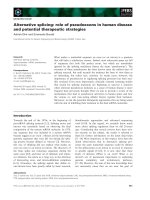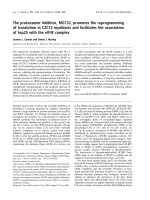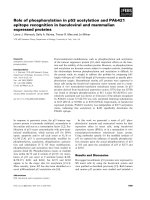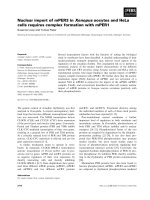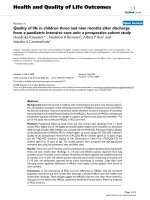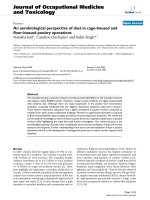code-mixing of english in hoa hoc tro magazine in vietnam patterns and readers’ attitudes = hiện tượng pha trộn ngôn ngữ anh trong báo hoa học trò ở việt nam hình thức pha trộn và thái độ của độc giả
Bạn đang xem bản rút gọn của tài liệu. Xem và tải ngay bản đầy đủ của tài liệu tại đây (1.53 MB, 72 trang )
VIETNAM NATIONAL UNIVERSITY, HANOI
UNIVERSITY OF LANGUAGES AND INTERNATIONAL STUDIES
FACULTY OF POST-GRADUATE STUDIES
o0o
TRẦN THỊ CÚC
CODE-MIXING OF ENGLISH IN HOA HOC TRO
MAGAZINE IN VIETNAM:
PATTERNS AND READERS’ ATTITUDES
(HIỆN TƯỢNG PHA TRỘN NGÔN NGỮ ANH TRONG BÁO
HOA HỌC TRÒ Ở VIỆT NAM:
HÌNH THỨC PHA TRỘN VÀ THÁI ĐỘ CỦA ĐỘC GIẢ)
M.A. COMBINED PROGRAMME THESIS
Hanoi, 2012
Field: English Linguistics
Code: 60 22 15
VIETNAM NATIONAL UNIVERSITY, HANOI
UNIVERSITY OF LANGUAGES AND INTERNATIONAL STUDIES
FACULTY OF POST-GRADUATE STUDIES
o0o
TRẦN THỊ CÚC
CODE-MIXING OF ENGLISH IN HOA HOC TRO
MAGAZINE IN VIETNAM:
PATTERNS AND READERS’ ATTITUDES
(HIỆN TƯỢNG PHA TRỘN NGÔN NGỮ ANH TRONG BÁO
HOA HỌC TRÒ Ở VIỆT NAM:
HÌNH THỨC PHA TRỘN VÀ THÁI ĐỘ CỦA ĐỘC GIẢ)
M.A. COMBINED PROGRAMME THESIS
Hanoi, 2012
Field: English Linguistics
Code: 60 22 15
Supervisor: Đỗ Thị Thanh Hà, Ph.D
iv
Lists of tables
Tables
Page
Table 1: Distinction between code-mixing and borrowing
5
Table 2: Parts of speech in Vietnamese
18
Table 3: Patterns of code-mixing
26
Table 4: Breakdown of switching by word classes
27
Table 5: Most frequent code-mixing phenomena
29
Table 6: -mixing used in the four extracts
41
Table 7: Details of understanding and feeling good about 4 extracts
42
Table 8
45
Table 9: Attitudes towards code-mixing of secondary and high school
students
57
v
List of figures
Figures
Page
Figure 1: Question 3: You often understand articles in Hoa Hoc Tro
Magazine with code mixing.
47
Figure 2: Question 4: You often feel comfortable when you read Hoa Hoc
Tro Magazine with code mixing
47
Figure 3: Question 5: In general, you prefer code-mixing in Hoa Hoc Tro
Magazine.
48
Figure 4: Question 6: Articles with code mixing often draw your attention
48
Figure 5: Question 7: You find it difficult to read the articles with English
code-mixing in Hoa Hoc Tro Magazine.
49
Figure 6: Q8: Code mixing of English in Hoa Hoc Tro Magazine destroys
Vietnamese impurity.
50
Figure 7:
53
Figure 8:
53
Figure 9: Preference of readers in different places
53
Figure 10: Attention level paid on code mixing in different regions
53
Figure 11: Difficulty had in different places
54
Figure 12: Agreement if code-mixing destroys Vietnamese impurity
54
vi
Table of contents
Candidate’s statement…………………………………………………………………………….i
Acknowledgement………………………………………………………………………………….ii
Abstract………………………………………………………………………………………… iii
List of tables…………………………………………………………………………………… iv
List of figures……………………………………………………………………………………….v
Table of contents………………………………………………………………………………… vi
CHAPTER I: INTRODUCTION i
1.1. Rationale 1
1.2. Scopes and aims 2
1.3. Research questions 2
CHAPTER II: LITERATURE REVIEW 3
A-THEORETICAL BACKGROUND 3
2.1. Code mixing 3
2.1.1. Code 3
2.1.2. Code mixing and code switching 3
2.1.3. Code-mixing and borrowing 5
2.2. Linguistics constraints on code- mixing 6
2.2.1. Particular grammatical constraints 6
2.2.2. Universal constraints on code- mixing 8
2.2.3. Extra-linguistic factors related to code-mixing 11
2.3. Patterns of code mixing 12
B - EMPIRICAL STUDIES 14
C - GENERAL REMARKS ON SYNTACTIC FEATURES OF
VIETNAMESE 16
CHAPTER III: METHODOLOGY 20
3.1. Data Corpus 20
3.1.1. Hoa Hoc Tro Magazine 20
3.1.2. Language of magazines 21
3.2. Corpus observation 22
3.3. Questionnaires delivery 22
vii
3.3.1. Sampling 22
3.3.2. Questionnaires 23
3.4. Data analysis 24
CHAPTER IV: PATTERNS OF CODE-MIXING FINDINGS AND
DISCUSSION 26
4.1. Findings of the quantification of mixed word class 26
4.2. Distribution of mixed words in the corpus 28
4.3. Overview description and discussion of mixed word classes 28
4.3. 1. Nouns 28
4.3.2. Verbs 34
4.3.3. Adjectives 36
4.4.4. Vocabulary combined between English and Vietnamese 38
CHAPTER V: READERS’ ATTITUDES TO CODE-MIXING FINDINGS
AND DISCUSSION 41
5.1. Part 1 of the questionnaires: Findings and Discussions 41
5.2. Part 2 of the Questionnaires: Findings and Discussions 41
5.3. Part 3 of the questionnaire: Findings and Discussion 45
5.4. Part 4 of the questionnaires: Findings and Discussion 52
CHAPTER VI: CONCLUSION 59
6.1. Summary 59
6.2. Implications 60
6.3. Limitations 60
6.4. Suggestions for further study 61
REFERENCES 62
APPENDIX
1
CHAPTER I: INTRODUCTION
1.1. Rationale
Under the influence of globalization, English has become worldwide popular and
used as a second language in many countries. Thus, many of these territories have
become multilingual with the frequent use of English in their daily life. Also, it is
no longer a rare phenomenon to find many English words used as substitutes
appearing in the newspapers or magazines of other languages, which has aroused
interest of various linguistic and sociological researchers. Sharing the same desire,
we also wished to get the holistic view on the process of producing such a mixture
of er tongue, Vietnamese, as well as the
reaction of Vietnamese, especially Vietnamese youth, towards the cases.
The reason for me to choose Vietnamese young people as the subject of study is
that they are assumed to have the highest frequency of mixing languages in their
daily environment. Obviously, as English have been nationwide taught in all
Vietnamese schools for the past ten years, they could be exposed to English at the
early age. As a result, English turns out to be familiar with them. Additionally,
under the boom of entertainment industry and Western influence, English, more or
less, become preferable in media. It was also proved by Leung (2010) that young
people preferred code mixing in advertising.
Since 1970s, quite a number of researches have been done on code-mixing both in
spoken and written languages in China, Hong Kong, Taiwan, and France. In 2003,
Ho-Dac Tuc also had a close view on spoken code-switching of English into
Vietnamese community in Australia. Though valuable results have been found, they
still leave the gaps for code-mixing in written language, i.e magazines and
newspapers for Vietnamese youth.
2
For all of the reasons listed above, this research was carried out to focus on
illustrating the patterns of rds code-mixing of English in
Hoe Hoc Tro Magazine, a magazine for Vietnamese youngsters, using eclectic
across qualitative and quantitative methods. The research, once finished, is expected
to shed some light on code-pers in general,
raise sociolinguistics related issues and lay foundation for further studies.
1.2. Scopes and aims
Although there are various dimensions of code-mixing and magazine languages to
be studied, this combination of qualitative and quantitative study only examines the
phenomenon of code-mixing in Hoa Hoc Tro Magazine in terms of its patterns and
-
mixing is more popular in spoken form.
1.3. Research questions
In order to rea
the mixture of code in Hoa Hoc Tro Magazine, the research answered two questions
as follows:
1) What are the patterns of code-mixing used in Hoa Hoc Tro Magazine?
2) s towards code-mixing phenomenon in Hoa Hoc
Tro Magazine?
3
CHAPTER II: LITERATURE REVIEW
A-THEORETICAL BACKGROUND
2.1. Code mixing
2.1.1. Code
dely seen in various field
may mean a system of computer programming instructions in computing, or
considered as a set of moral principles or rules in laws or even systems of symbols
system of words, letters, numbers or symbols that represent a message or record
th
ed, OUP)
is implemented. To be specific, in this study, Code is defined as
component that can be as small as a morpheme or as comprehensive and complex as
2.1.2. Code mixing and code switching
The terms code alternation, code mixing and code switching have grounded heated
debates in distinguishing. Different definitions of code mixing, code switching as
well as the differentiation between the thereof have been proposed.
The first point of view was raised by Clyne (1991) who argued that there is no
However, Bentahila and Davies (1983) held the second view point that code-
mixing is the random alternation of two languages within a sentence. Wei (1998)
also shared the same idea that if code alternation occurs at or above clause level, it
is considered code switching, but if it occurs below clause level then it is considered
code mixing. According to Bhatia and Ritchie (2004), code-
of various linguistic units (morphemes, words, modifiers, phrases, clauses and
4
However, in her (1980)
defined code switching the alternation of two languages within a single
discourse, sentence or constituent and divided code switching into three types
including tag switching, inter-sentential and intra- sentential ones.
The first type, tag-switching, related to the inclusion of a tag (e.g: you know, OK,
right, etc), can be illustrated in the following example of Portuguese- English
bilingual:
I never stop!] The second type, inter-sentential switching occurs in clausal level or
between sentences. A case in point
start a sentence in English and finish in Spanish]. The third type is intra-sentential
code switching. Below is an example of a Portuguese
(Jalil. A, 2009).
Therefore, both Poplack (1980) and Holmes (1992) proposed another view point
which refers the third type, intra-sentential code switching, as code-mixing. In other
words, code-mixing is a sub-type of code switching. This is also agreed by Liu, P.
-mixing is used
synonymously with code switching and means basically intra-sentential code
It is shown that the phenomenon defined differently as a result of different research
interest as well as how researchers view the phenomenon. In this study, we adopt
the third view point. In brief, code switching refers to both inter-sentential and
intra-sentential code-alternation occurring when a bilingual speaker uses more than
one language in a single utterance above the clause level to appropriately convey
his/her intents, thus code switching relates to participants and discourse. Mean
while code mixing refers to mixing the various language units below clause level
within a sentence, which results no discourse meaning occurring sentence
internally.
5
2.1.3. Code-mixing and borrowing
As code-mixing is defined as a subtype of code-switching in this study, the
distinction from code mixing and borrowing will be taken as the difference between
code- switching and thereof.
There has been a variety of studies trying to make a distinction between code-
mixing (as a subtype of code-switching) and borrowing. Some scholars take them as
related processes (Bentahila and Davies, 1991) and should not be considered as
distinct entities while many others consider them as distinct processes (Poplack
1980; Muysken 1987).
Poplack and Sankoff (1984) (see Tuc (2003:9)) discussed the relationship between
code-mixing and borrowing as follows:
Code mixing
Borrowing
Frequent use
-
+
Synonym displacement
-
+
Integration:
Phonological
+/-
+/+
morphological
-
-
Syntactic
-
+
Acceptability by native speakers
-
+
Table 1: Distinction between code-mixing and borrowing
It is obvious seen from the table that borrowing is used more frequently with the
integration of phonology and syntax, and accepted by native speakers. Unlike code
6
mix
borrowed into Vietnamese with phonological adaptation. As in Vietnamese, they
a
, - --,
--
become common in daily conversation among monolingual Vietnamese. That is
also another point separating borrowing from code mixing. In terms of
degree of competence, borrowing needs only monolingual competence, whereas for
the occurrence of code mixing, speakers should master both languages in order to
.
Though the distinction between code-mixing and borrowing is still far from clear,
has proved that the two
phenomena have certain differences. As a result, this study takes Poplack and
rinciples for distinguishing. In short, code-mixing
differs from borrowing in terms of the frequency used, the morphological,
phonological and syntactic integration as well as acceptability of and requirement
from native speakers.
2.2. Linguistics constraints on code- mixing
Sociolinguists have been interested in not only the functions, meanings and patterns
of code mixing but also the points at which code-mixing occurs in the sentence. In
other words, what are the constraints on code-mixing? Basing on what has been
researched by Muysken (2000), studies on constraints of code-mixing have
undergone three stages: (i) an early stage focusing on grammatical constraints
specific to particular constructions of specific languages; (ii) the later stage with
classical studies in around 1980s exploring universal constraints on code-mixing;
(iii) the present stage, which may be characterized by the search for new
perspectives of mixing strategies and relative constraints to particular strategy.
2.2.1. Particular grammatical constraints
7
In 1970s, a large amount of research was carried out to study specific constraints on
code mixing (Gumperz and Hernandez- Chavz 1975; Timm 1975; Lipski 1978;
Plaff 1979). Most of these studies looked at a specific case of code-mixing and
impose specific constraints rather than formulating universal constraints.
Drawing on Spanish- English conversations of Mexican Americans and Puerto
Ricans, Gumperz and Hernandez- Chavz (1975) noted that code mixing was easily
possible in such context as:
(1) between a head noun and a relative clause
(2)between a subject and a predicate in a copular construction.
Likewise, Timm (1975) also proposed the following constraints on Spanish English
code- mixing:
(3) Subject and object pronouns must be in the same language as the main
verb.
(4) An auxiliary and a main verb, or a main verb and an infinitive must be in
the same language.
However, the above studies do not provide any examples from other language pairs
that would confirm their constraints. Specific language constraints studies continued
to be observed and followed by Lipski (1978) with two major findings including:
(5) It is difficult to switch inside a prepositional phrase
(6) It is impossible to switch between the article and the noun.
However, these were counter-acttacked by Plaff (1979). After analyzing a large
number of cases, it was found that mixing internal to prepositional phrases (PPs),
i.e. of English nouns into Spanish PPs happens far more often than mixing at PP
boundaries. Also, more cases of a switch between the article and the noun are found
than switches between article + nouns combinations and the rest of the sentence.
Obviously, it turned out to be difficult to rely on judgement data.
Therefore, it has been recognized that the specific constraints are applicable with
these language pairs code mixing but fail to explain the phenomenon among other
8
diverse pairs. This impair proved the necessity and the extent stimulation of a
general theoretical constraints in later studies on code-mixing.
2.2.2. Universal constraints on code- mixing
From 1980s onwards, scholars have turned their directions to proposing universal
models for code-
Equivalence Contraints, Government Constrain and Myers-Scottons
(1993a)
a. Poplack’s Equivalence and Free Morpheme constraints
In Poplack (1980), The Equivalence constraint is stated as follows:
Code-switches will tend to occur at points in discourse where juxtaposition of
L1 and L2 elements does not violate a syntactic rule of either language, i.e. at
points around which the surface structure of the two languages map onto each
other. According to this simple constraint, a switch is inhibited from occurring
within a constituent generated by a rule from one language which is not shared
by the other.
(Poplack 1980:586)
In other words, code-mixing would only occur within sentences at points where the
grammars of both languages match each other, which can be illustrated in the
following example:
I told him that so that he would bring it fast.
(Yo) le () la trajera
(Poplack 1980 :586)
Similarly, Holmes (1992) gave an example of mixing an adjective and a noun if
both languages use the same order for that adjective and noun.
English
French
Possible switch point?
red boat
bateau rouge
NO
9
big house
grande maison
Poplack (1980) also proposed another principle called Free Morpheme Constraint,
may be switched after any constituent in discourse provided
that constituent is not a bound morpheme -6). This principle
between a bound morpheme and lexical form unless the latter has been
phonologically integrated into
prohibited to switch between a free and bound morpheme basing on this constraint.
These two constraints are based on English Spanish data. However, when Poplack
and Sankoff (1988) extended their applicability to other language pairs, they were
criticized by many other scholars whose studies showed counter-examples to the
two mentioned constraints. Eliason (1990) even compiled a list of counter-examples
and arguments against the two constraints based on Maori- English data (as cited in
Tuc, 2003). These arguments and many other counter-examples have led
e very
powerful, they still cannot be universally applicable to all code-mixing cases of
language pairs but need relativising when considered.
b. Government Constraint
Another attempt to claim code mixing was made by Di Sciullo, Muysken and Singh
(1986) who incorporated a number of universal principles within a Government-
Binding framework of Chomsky (1981) to propose Government Constraint. The
Government-Binding framework, a theory of syntax and a phrase structure
grammar (as opposed to a dependency grammar) in the tradition of transformational
grammar, which includes two central subtheories of the theory: government, which
is an abstract syntactic relation, and binding, which deals with the referents
of pronouns, anaphors, and referential expressions. Government explains the
governing relationship while binding reasons the ungrammaticality of the two
elements. In the Government constraint developed later, mixing is only possible
10
between elements that are not related by government. In detailed, switching subjects
and verbs is allowed, but not between verbs and objects or within a prepositional
phrase. The relation between and its syntactic environment is restricted by the
relation of government. However theoretically appealing this constraint is, it still
faces challenges as the class of governors include both content words and functional
categories (Ho, 2003). Nortier (1990), who studied Dutch-Morroccan Arabic code-
mixing in detail, presented counter-evidence to the government constraint. There
are no less than 14 cases of mixing between verbs and indirect objects and 97 mixes
of object noun phrases involving a single noun. Demonstrated all the counter-
examples, the government constraint is apparently in adequate. The problem now is
not only universal basis but if it is supported when applied in specific language
pairs.
c. The Matrix Language Frame Model
In 1993, Myers- Scotton rejected all the earlier constraints to propose her full
account of ambitious model called The Matrix Language Frame Model which holds
that when an intra-sentential code switching occurs, the distribution of two
languages is asymmetrical. One is the Matrix Language (ML) which is more
dominant, and the other one is Embedded Language (EL). ML can also be identified
as the first language of the speaker. As structural constraints are imposed on code-
switched utterances, system morphemes (e.g. tense and aspect inflections) will
always come from the ML, and the order in which morphemes may occur in code
switched utterances will be determined by the MLF.
Below is an example of MLF, the content words (in capitals) are from English, the
EL while the other morphemes and other characteristics such as prefixes, subject,
person, number and gender are from the ML, Swalli.
Eg:
Leo si-ku-COME na-BOOK z-angu
(Holmes, 1992)
11
Myers-s work, despite making the distinction between content (nouns,
verbs, etc.) and system (articles, inflections, etc.) morphemes in the EL, has been
criticized for a number of points: there has not been a clear-cut definition of system
morphemes, the notion of ML frame is too rigid and the psycholinguistic processing
model is assumed far from explicit.
In brief, there are there prominent theories on universal constraints on code-mixing.
Equivalence and Free Morphemes Constraints limit the scope of code-mixing in the
equivalence of word order and words category. In other words, code-mixing cannot
happen if the two languages do not have the same structures or a free morpheme can
be switched with a bound one. In Government Constraint, code-mixing will not
happen between certain types of word categories or within prepositional phrase in a
clause. Matrix Language Model illustrates a frame in which system morphemes are
embedded into the matrix language. All these theories, either reach agreement or
attacks from research community, carry unconvincing counter-evidence to attack
themselves. While the two former constraints could not be applied to all specific
language pairs, the later one failed to define and distinguish the notion of system
morphemes (Muysken, 2000). Thus, it is reasonable to admit that adequate
formulation of constraints on code-mixing are not yet possible. This study is not
meant to support any specific constraint of code-mixing but rather take these
constraints into consideration when dealing with English and Vietnamese in contact
in a given corpus.
2.2.3. Extra-linguistic factors related to code-mixing
Bentahila and Davies (1995) realized that code-mixing could not be satisfactorily
only along the dimensions of structural constraints or rhetorical functions. A
consideration of such extra-linguistic factors as age, sex, social networks will play
an equal role in explanation the patterns of code-mixing as well. For instance,
Poplack (1980) reported it her study of English- Spanish bilinguals that code mixing
was used by those with high proficiency in both languages than those with less
proficiency in English.
12
However, the selection of extra-linguistic factors to establish the network is not
simple. According to Kerswill (1994, cited in Tuc, 2003), the selection requires the
researcher to have the knowledge of the community under investigation. As the
matter of fact, the research, without the knowledge needed, will unlikely to able to
choose which variable as the most important in the relationship with linguistic
behaviors.
Myers- Scotton (1993a) made an attempt to provide a general theoretical
explanation of the sociolinguistic and pragmatic aspects of code-mixing called
. Code-mixing is considered as a socially functional
a given social context, if
there are some conventionalized of code choice and code use, which are expected
the majority of speakers, this is called code mixing as unmarked choice. Whereas, if
the speaker uses the unexpected code to negotiate or achieve a strategic effect in
conversation, it is called marked code.
The theory of Markedness model as well as the role of extra-linguistic factors are
valuable to the researcher when she analyzes the patterns of code-mixing in the
corpus in later parts. In this study, the use of English in magazine is regarded as a
marked choice because the normative medium (i.e., the unmarked choice) of written
communication in Vietnam is Vietnamese. Hence, this study will also explore the
-than-
2.3. Patterns of code mixing
Based on structural linguistics and sociolinguistics, code mixing was classified into
three processes, namely insertion, alternation, and congruent lexicalization
(Muysken (2000)).
Insertion: Insertion happens when lexical items are incorporated/transferred/
embedded/ inserted into another language.
13
Alternation: occurs when structures of two languages are alternated indistinctively
both at the grammatical and lexical level.
Congruent lexicalization happens when two languages share grammatical
structures which can be filled lexically with elements from either language
(Muysken, 2000).
14
These classification is of worthy consideration. However, these processes are too
complicated; besides the distinction between the first and third type is not yet clear.
Therefore, in order for an easier approach, the researcher did not apply this
categorization but took the methods of categorizing codes mixed in terms of their
parts of speech such as Nouns, Verbs, Adjectives, Adverbs and others. This
classification was already done in the empirical studies carried out by different
researchers before. A clear justification of these empirical studies will be illustrated
in the following part.
B - EMPIRICAL STUDIES
One of the pioneer of studying code alternation, especially code-switching, of
English into Vietnamese is Ho Dac Tuc. In his study of Vietnamese-English
Bilingualism (2003), he chose Vietnamese community in Melbourne, Australia as
the subject of the study. Totally, there were sixty informants with an equal number
of males and females, ranging from eighteen to sixty-two of age, being interviewed.
The findings showed that among 3157 codes switched found in the corpus, nouns
occupy the highest percentage (50,61%), followed by verbs (12,35%) and adjectives
(4,6%). Other parts of speech contribute about 10%. What is special here is the ratio
of switching at clause level takes almost one fifth of all the switched cases. Almost
the English codes are about house hold, working and daily life activities.
The findings of this study would be compared to those of Tuc
Nevertheless, as the focus of this study is intra-sentential code mixing, all the cases
of English switched above clause level will not be counted. Also, as the given
corpus is a magazine written in spoken language, the method of data collection will
be of difference. No interview will be recorded but will be observed through
publications of mentioned Magazine.
Code-mixing in written forms, i.e in the newspapers and magazines have been
widely researched in Chinese communities.
15
Chen (2006) investigated code-mixing of English in magazine advertisement in
Taiwan. From 64 volumes of 43 different magazines published in Taiwan in 2004,
226 code-mixed sentences were collected and analyzed. The results show that noun
phrases occupy almost half of the expressions used. Also, a questionnaire survey
was administered just to find out that respondents have quite positive attitudes
towards code-mixing in advertising. Likewise, Leung (2010) did an empirical study
on code mixing in print advertisement in Hong Kong, a society where both English
and Chinese are official languages and code mixing in print advertisement is quite
common. 278 questionnaires sent to local Chinese residents revealed that (1) most
code-mixed advertisements could be understood, (2) the products considered to be
advertised with code-mixing are convenience and shopping ones and (3) code-
mixing in advertising is more preferred by young and educated people. Kia (2011)
and his Malaysian colleagues identified the features of English lexical items code-
mixed into Chinese entertainment news. Around 1000 English code-mixed
sentences in Chinese entertainment news were collected from three dailies in 2007
to be analyzed qualitatively. Survey questionnaires were also delivered to
respondents to find out their opinions on the features of some English lexical items
code-mixed into the sentences of Chinese entertainment news. It was found that
many English abbreviations were inserted into Chinese entertainment news to make
so that is has the same grammar characteristics as Chinese. Many nouns and verbs
change their parts of speech when code-mixed into Chinese entertainment news.
Clearly, the language pair in the three studies above is dissimilar with the current
study and the corpuses for investigation are not the same. However, the method of
collecting data, conducting questionnaires could be practical in the current study. To
researches in different context with different corpus. At the same time, unlike the
focus of the studies on advertisement in different magazines, it is to focus on a
variety of columns but only in one magazine.
16
To sum up, this study has reviewed linguistics constraints including specific and
universal ones as well as extra-linguistics influential factors to code-mixing. In this
study, Markedness Model and Matrix Language will be implemented as back-up
theories. Also, the study also wishes to fill the gaps left by the empirical studies
about code-mixing in written language in the context of Vietnam.
C - GENERAL REMARKS ON SYNTACTIC FEATURES OF
VIETNAMESE
According to Tuc (2003), in general terms, Vietnamese sentences range from a
single word to lengthy co-ordinate structures of clauses. A sentence of any structure
in Vietnamese can be summarized in the following formulation:
S = [Nom] +V + [O] + [{F, Q}]
In the sentence, Verb or Verb phrase is a compulsory element which is optionally
preceded by a nominal and followed by an object (O) and a final particle (F), or a
question marker (Q). Tuc (2003) proposed the above formula with the use of square
brackets [ ] indicating optional elements while the braces { } for showing the choice
of at least one of the included optional forms.
This can be demonstrated in these following sentences:
(1) Declarative sentence:
.
(2) Imperative sentence:
!
You go Particle
17
(3) Interrogative sentence
?
You go Particle
So, different types of sentences can be generated from this formulation. The
declarative sentence takes neither F nor Q. By contrast, the request or imperative
sentence has a similar structure to that of the interrogative sentence in that it can
take either F or Q.
As mentioning to parts of speech, Nguyen, Hong Con (2003) divided Vietnamese
lexis into ten types of words as below:
In order to make it clearer, basing on their main functions in the sentence,
Vietnamese vocabulary consists of noun, pronoun, verb, adjective, number,
attribute, adverb, conjunction, preposition, particle, modal particle.
Vietnamese parts
of speech
1. Noun
2. Pronoun
3. Verb
18
4. Adjective
5. Number
6. Attribute
7. Adverb
8. Adverb
9. Conjunction
10. Preposition
11. Particle
12. modal particle
Table 2: Part of speech in Vietnamese
Meanwhile in English, basing on structures and functions in the sentence, parts of
speech consist of two groups namely open-class and closed system items. Those in
open class are Noun (John, room, answer, play), adjective (happy, steady, new,
large, round), adverb (really, very, then, happily) and verb (search, grow, play, be,
have, do). Closed-system items include article (a, an the), demonstrative (that, this),
pronoun (he, they, anybody, one, which), preposition (of, at, in, without, in spite of),
conjunction (and, that, when, although) and interjection (oh, ah, uh, phew).
Through comparing and contrasting the morphology of the two languages, the
similarities and differences of the two languages are made explicit. Needless to say,
19
there are content words in both language systems. However, as the unlike
characteristics in grammar, opposite points in function words such as particles are
clearly seen.


